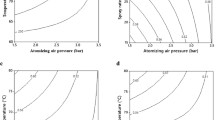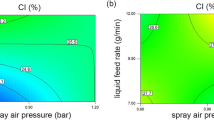Conclusion
The results of the experiments have revealed that the optimal operating conditions for a lab scale Aljet mill are at the high level (110 psi) of the pushing nozzle and the low level (65 psi) of both grinding nozzles, or vice versa. Operating the Aljet mill at high pushing and grinding pressures also produces small particle size; however, the high pressures require more gaseous fluid making the process less efficient. At a very low pushing nozzle pressure as compared with the grinding nozzle pressure, the material kicks back from the mill, reducing the yield. Optimization of the lab scale Aljet mill operating conditions will be very useful in particle size reduction of poorly water-soluble compounds and is particularly beneficial at early stages of drug development when the drug quantity is very limited.
Similar content being viewed by others
References
Heng P, Wong T, Shu J, Wan L. A new method for the control of size of pellets in the melt pelletization process with a high shear mixer. Chem Pharm Bull. 1999; 47(5):633–638.
Swarbrick J, Boylan J, eds. Encyclopedia of Pharmaceutical Technology: Unit Processes in Pharmacy: the Operations. Vol 16. New York, NY: Marcel Dekker, 1997:1–114.
Geze A, Venier-Julienne M, Mathieu D, Filmon R, Phan-Tan-Luu R, Benoit J. Development of 5-iodo-2-deoxyuridine milling process to reduce initial burst release from PLGA microparticles. Int J Pharm. 1999; 178:257–268.
Vidgren P, Vidgren M, Paronen P. Physical stability and inhalation behaviour of mechanically micronized and spray-dried disodium cromoglycate in different humidities. Acta Pharm Fenn. 1989; 98:71–78.
Rasenack N, Muller B. Dissolution rate enhancement by in situ micronization of poorly water-soluble drugs. Pharm Res. 2002; 19(12):1894–1900.
Kawashima Y. Nanoparticulate systems for improved drug delivery. Adv Drug Deliv Rev. 2001; 47:1–2.
Fincher J. Particle size of drugs and its relationship to absorption and activity. J Pharm Sci. 1968;57(11):1825–1835.
Parrott E. Milling of pharmaceutical solids. J Pharm Sci. 1974;63(6):813–829.
Dobson B, Rothwell E. Particle size reduction in a fluid energy mill. Powder Technol. 1969–70; 3:213–217.
Nykamp G, Cartensen U, Muller B. Jet milling-a new technique for microparticle preparation. Int J Pharm. 2002; 242:79–86.
Akbarieh M, Tawashi R. Morphic features of solid particles after micronization in the fluid energy mill. Int J Pharm. 1987; 35:81–89.
Mehta K, Kislalioglu S, Phuapradit W, Malick W, Shah N. Multi-unit controlled release systems of Nifedipine and Nifedipine: Pluronice F-68 solid dispersions: characterization of release mechanisms. Drug Dev Ind Pharm. 2002; 28(3): 275–285.
Author information
Authors and Affiliations
Corresponding author
Rights and permissions
About this article
Cite this article
Vatsaraj, N.B., Gao, D. & Kowalski, D.L. Optimization of the operating conditions of a lab scale Aljet mill using lactose and sucrose: A technical note. AAPS PharmSciTech 4, 27 (2003). https://doi.org/10.1208/pt040227
Received:
Accepted:
DOI: https://doi.org/10.1208/pt040227




